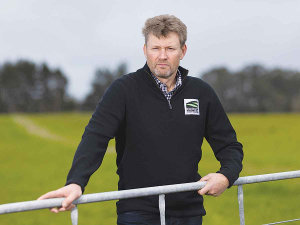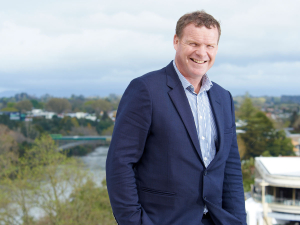“Being part of this project means we’re out there with our pants down and we can’t hide from the truth.”
Jon’s talking about the Communities of Practice (COP) project, which began in July 2019. Led by DairyNZ, the project is helping Otago and Southland farmers improve their water quality and reduce their emissions footprints. While separate from research being done at the Southern Dairy Hub, the COP project is adding another dimension to ongoing Hub research by enabling calculation of the greenhouse gas footprints of the four current farm systems.
That’s why Jon and wife Birgit don’t mind putting their farm in the spotlight.
“It’s okay by me because this project is levy-funded and aimed at benefitting all farmers. We knew that when we signed up for it.”
Now in their sixth season on their Brydone farm, Jon and Birgit milk 380 Friesian cows on 139ha (plus 100ha across two leased support blocks for wintering and young stock), with the help of their two team members.
Before getting on board the COP project, Jon had already been involved in the Southern Dairy Hub, spending three years on the trust that initially set it up in 2014/15. He was keen to get involved in the COP project.
“We’re a System 5 farm, which isn’t typical for a New Zealand farm. I really wanted to find out about what impact we were having on the environment. I also wanted to get skilled up into what’s coming our way with environmental regulations and policy, and find out what changes are achievable. Having the access to the modelling from DairyNZ through this project gives us an idea of that.”
Now well into its second year, the COP project is specifically targeted at protecting water quality and better understanding greenhouse gas emissions (GHGs) from systems in Otago and Southland. It also aims to pinpoint any knowledge gaps and future research opportunities for the region.
DairyNZ senior scientist and COP project leader Dawn Dalley says that, although led by DairyNZ, the project includes valuable input from AgResearch’s GHG and sediment research expertise. The other three monitor farms are in northern Southland, west Otago, and Taieri. All are farmer owner-operated, except for the west Otago farm, run by sharemilkers.
The farms cover a wide range of farm systems, topography and landscapes, with contrasting vulnerabilities related to slope, soil type and wetness. Each has its own ‘Community of Practice’, made up of a group of eight to fifteen farmers and rural professionals attached to each farm, who have an interest in achieving improved environmental outcomes for the region.
Regular meetings take place for each of the four farms, and their whole systems are analysed, alongside feed quality analysis, environmental risk assessment and financial benchmarking. Farmax and Overseer models were set up to model current practice and alternative scenarios, with baseline information collected in DairyNZ’s DairyBase.
As well as the water quality and emissions focus, the project also looks at monitor farms in terms of their financial and farm systems performance. This was great forward-thinking, says Dawn, as it means the COP project aligns well with DairyNZ’s Step Change project.
“Step Change is focused on dairy farmers nationwide,” says Dalley. “It was launched after the COP project began, but the two initiatives match up almost exactly – both addressing nutrient loss to water, GHGs and financials. For both, the regional team are integral to delivery.”
While the COP project is separate, it complements research at the Southern Dairy Hub. Dawn says the Hub provides a foundation that “allows us to record all the information necessary to get the methodology right, with really robust data and control, and a good understanding of the systems”.
“For instance, for the calculation of the GHGs that AgResearch is going to do, we’ll be using the Hub’s approach to pilot that. That will also help extend the reach of the farm systems research at the Hub, and enable possible mitigations to be tested across a wider range of farm systems on commercially operating farms.
“For now, though, the main focus of this project is to get the modelling right for each of its four monitor farms,” says Dalley. “Then, when the Southland targets/limits are finally set, the learnings will provide the tools, resources and approach farmers can use to put things into action, taking into account the limits.”
Dalley says having the linkages with the SDH and farmer reference group has given the project team the insights they needed around what those farmers have and what they need, and what’s needed in the development in the project itself.
Jon says there are a couple additional bonuses he’s noted too. “Farmers are getting someone come onto the farm and pick holes in the system, which is great. It confirms where we’re going and gives us more confidence in moving forward.”
“Not only that, you get free access to two analysts and three well-respected scientists – where else can you get that to this degree? That access to the experts and their knowledge is really awesome.”
“It’s also been great working with Dawn Dalley and the team, including the AgResearch scientists.
“I feel this project is going to give us more tools to work with, and to understand how New Zealand farming might be in 10 years’ time.”
Farm Facts
- Name: Jon and Birgit Pemberton
- Position: Farm owner-operators
- Location: Brydone, east Southland
- Farm size: 139ha (effective) plus two leased blocks (total 100ha)
- Herd size: 380 cows (Friesian)
- Production: 220,000kgMS/year (2019/20 season)
Time To Get Real
One of the key outcomes the project team wants to see alongside the water quality gains, is an increase in farmer understanding of GHGs and their GHG footprint.
The project will also inform the framework of He Waka Eke Noa. For the Pembertons, it's the action on the ground that will show the project's full value.
"Projects like this one and Step Change show real inputs and outputs off-farm," says Jon
"It's about having confidence in the modelling, so we can turn around the unintended consequences of intensive land use. It doesn't matter whether you're running a System 1 low-input farm or a System 5-high input farm - a good farmer will make it happen.
"There is a lot of debt in our industry that could potentially limit options for a system change or affect the rate of pace to keep up with new national policies. We certainly have our fair share of debt on this farm, so we hope using our business to illustrate where the opportunities and challeges are will help the dairy sector and wider New Zealand stay relevant.
"There are also plenty of other young couples in our position, and it's nice to be able to see a way forward. We want to help other people see that there's light at the end of the tunnel, that they can keep their business tracking along, if this project can give people the tools, knowledge and skills they need to catch up, that's great."
Story – DairyNZ


















